Overview
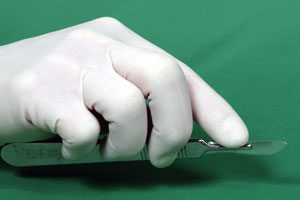
- surgeon's main cutting tool.
- least traumatic way to divide tissues
- best for incising
- dense tissues
- tissues that can hold under tension while making the incision
Goal
- to use a single pass to completely incise the tissue to the desired depth
Skills to Practice
- fingertip grip
- palm grip
- pencil grip
- creating an incision edges with consistently perpendicular to the tissue’s surface
- controlled depth of incision for the entire incision's length
- making the desired length of incision in a single pass
- making a controlled entry into a cavity using the pencil grip
Holds
Fingertip Grip
- most common grip
- used to make a long, smooth incision
- provides the best accuracy and blade stability when making long incisions
- maximizes contact of blade's cutting surface with the tissue

The Hold
- handle held in the dominant hand
- cutting pressure applied by fingers (primarily index finger)
- entire arm, not just the hand, moves to make the incision
Palm Grip
- strongest grip
- used when need strong pressure to incise the tissue
- uses entire arm
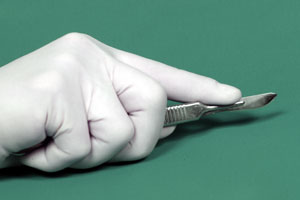
The Hold
- hold handle in palm of dominant hand
- place thumb on one side of handle
- rest index finger on top of handle or blade (optional)
- wrap remaining fingers around the handle
- cutting pressure applied by palm and fingers
- entire arm moves to make the incision
Pencil Grip
- this grip limits amount of the blade’s cutting surface contacting the tissue.
- useful for short, precise incisions
- jagged cut occurs when used to make longer incisions
The Hold
- handle is held in dominant hand like a pencil
- handle is held between the thumb and index finger
- handle rests on remaining fingers
- fingers are moved to make the incision rather than arm
- blade can be reversed for improved visualization and control as shown below on the right
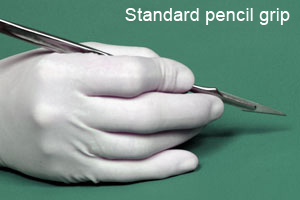 |
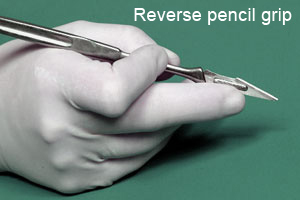 |
Reverse pencil grip
How to Use
Slide Cutting
- typically uses fingertip grip and belly of blade
- increases tissue’s contact with blade’s cutting surface
- cushions against sudden changes in pressure and directions
- used for long tissue incisions
- pressure exerted by index finger on the blade is adjusted according to the tissue’s innate toughness and desired depth of incision desired
- skin is stretched laterally on either side of the proposed incision by the non-dominant hand
- stabilizes tissues so easier to cut
- opens edges to monitor incision depth
- this hand is advanced as incision progresses
- blade remains in contact with surface and advances until incision is complete
- right handed surgeons: generally make incisions left to right or towards their bodies
- left handed surgeons: generally make incisions from right to left or towards their bodies
Slide cutting video 1
Press Cutting
- typically uses the pencil grip and tip of the scalpel blade
- makes a stab incision
- used to enter abdominal cavity or hollow organ
Standard technique
- tip placed on surface of cavity or hollow organ
- pressure applied to tip until it enters the cavity
- tendency to enter cavity suddenly (poor control)
- index finger may be placed along side of blade as a “stop” to control depth of penetration
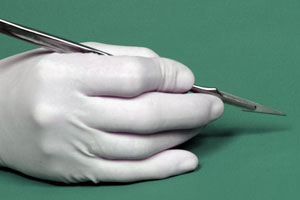
Reverse technique
- blade is reversed so cutting surface is faces surgeon
- this allows:
- improved control over depth and rate of penetration
- improved visualization
- improved protection of vital underlying tissues
- recommended in most situations
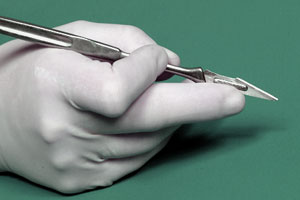
Skills to Master
The Goal
The goal when using a scalpel blade is to use a single pass to completely incise the tissue to the DESIRED depth and length.
Practice: Scalpels
- controlled depth of incision
- making the desired length of the incision in a single pass
- creating incision edges perpendicular to the tissue's surface
- making a controlled entry into a cavity (e.g. abdominal cavity or a hollow organ)
Controlled depth of incision
- a tentative cut requires multiple attempts to reach the desired depth and creates jagged edges (this is inefficient and traumatic)
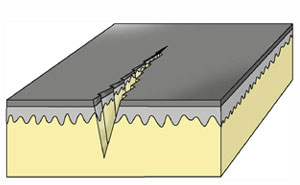
jagged edges created by tentative cut
- too strong an incision may damage deeper structures
Practice: Incise different fruit (eg. banana/orange/mango)
- use fingertip grip and slide cutting technique
- single complete incision from top to bottom
- incision perpendicular to the “skin”
- no stopping
- cut through only the skin of the fruit
- practice until you can consistently and efficiently use a single pass to completely incise various "tissues" to the desired depth
Desired Length
Making the desired length of incision in a single pass
- decide in advance the location and length of incision required
(Remember that an incision heals from side to side not end to end)
- the slide cutting technique with a fingertip grip is most commonly used.
Incision Fingertip Grip
Controlled Entry
Making a controlled entry into the abdominal cavity or a hollow organ
- Ensure vital structures in the area are protected and avoided
- scapel is held using either the standard or reverse pencil grip
- tip of the blade is placed on the tissue or organ
- middle finger can be placed along side of blade to serve as a stop
- steady pressure is applied to the tip until it penetrates the tissue or organ
- the blade is then withdrawn
- practice withg different tissues until consistently controlled entries are achieved

